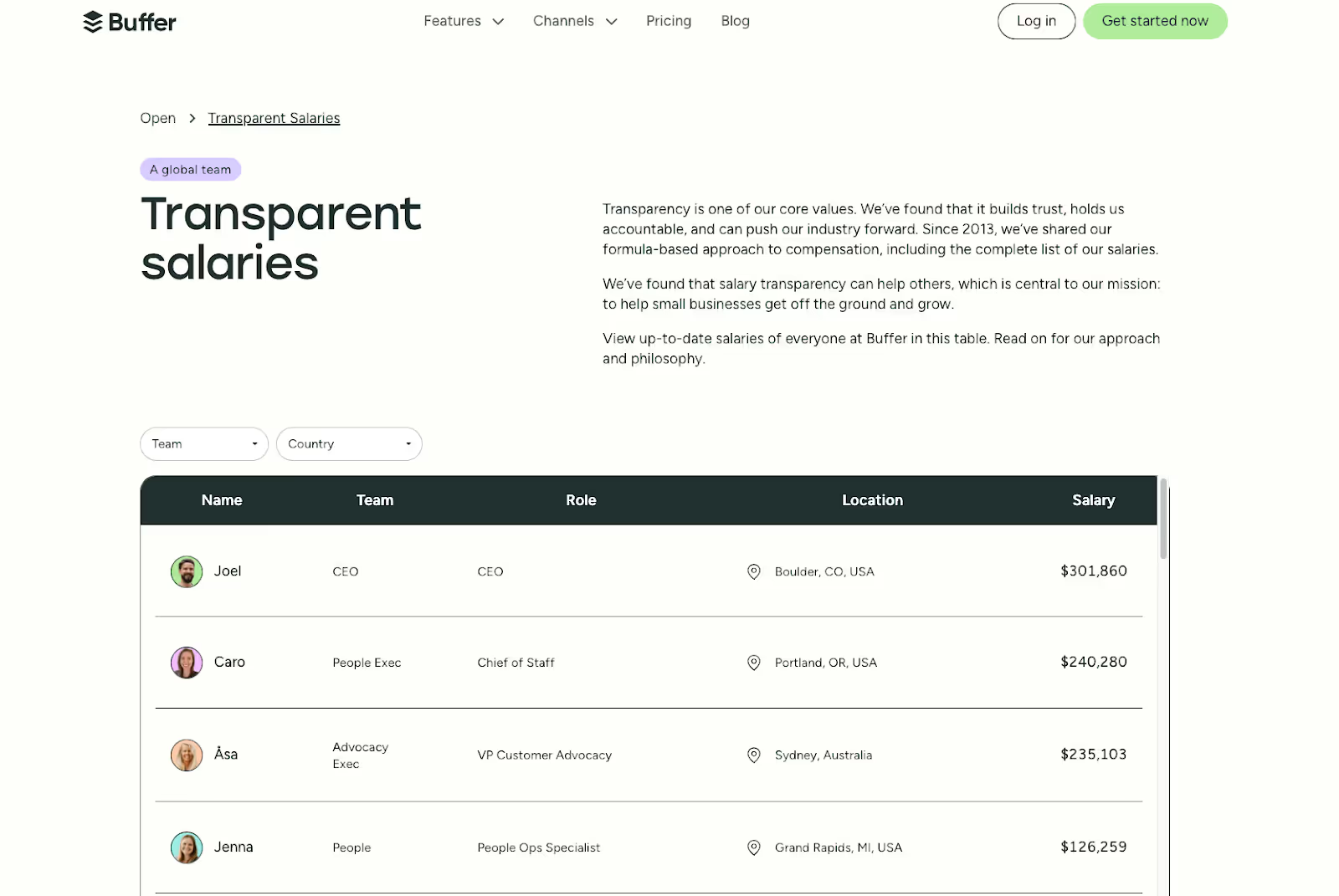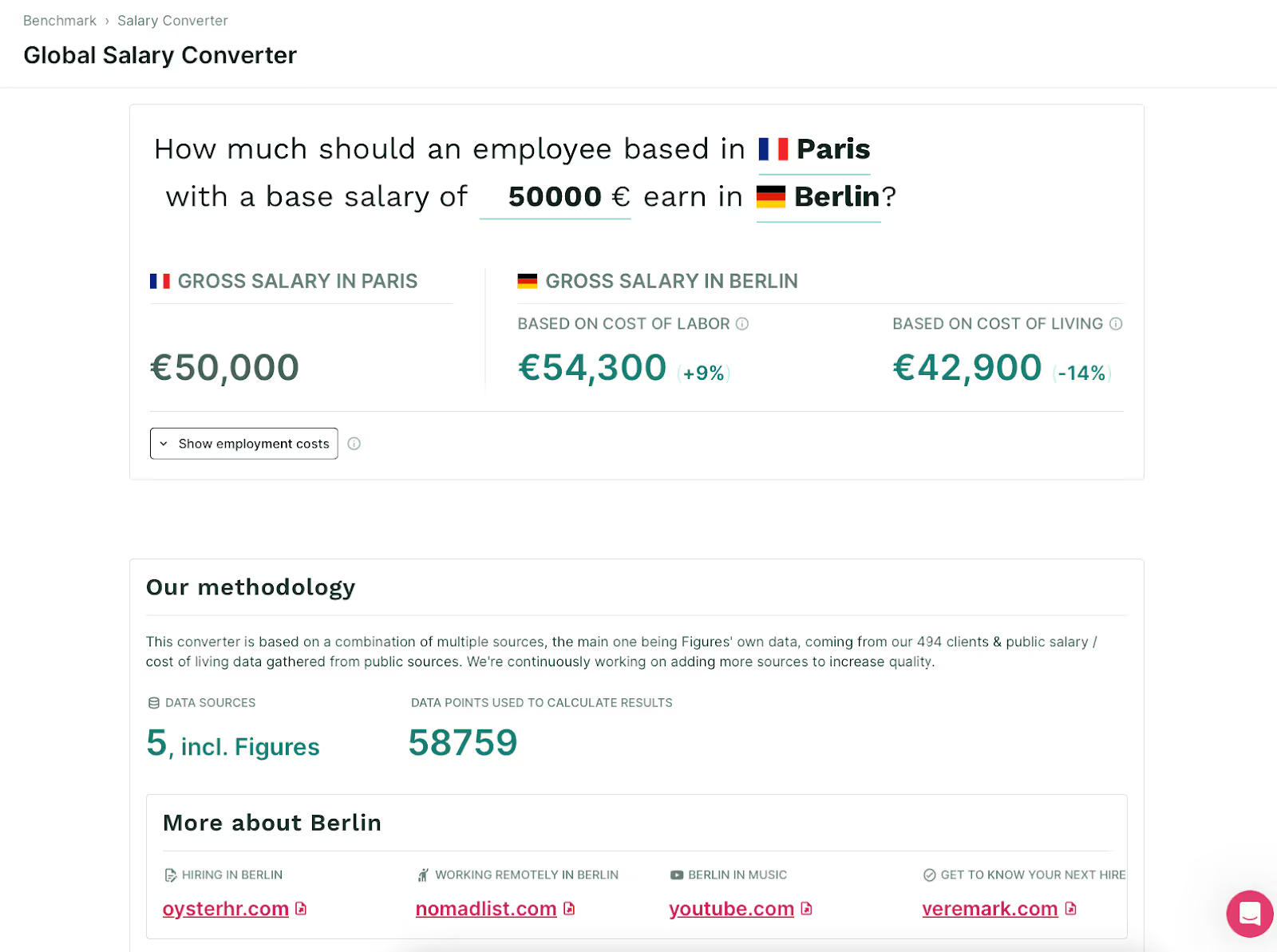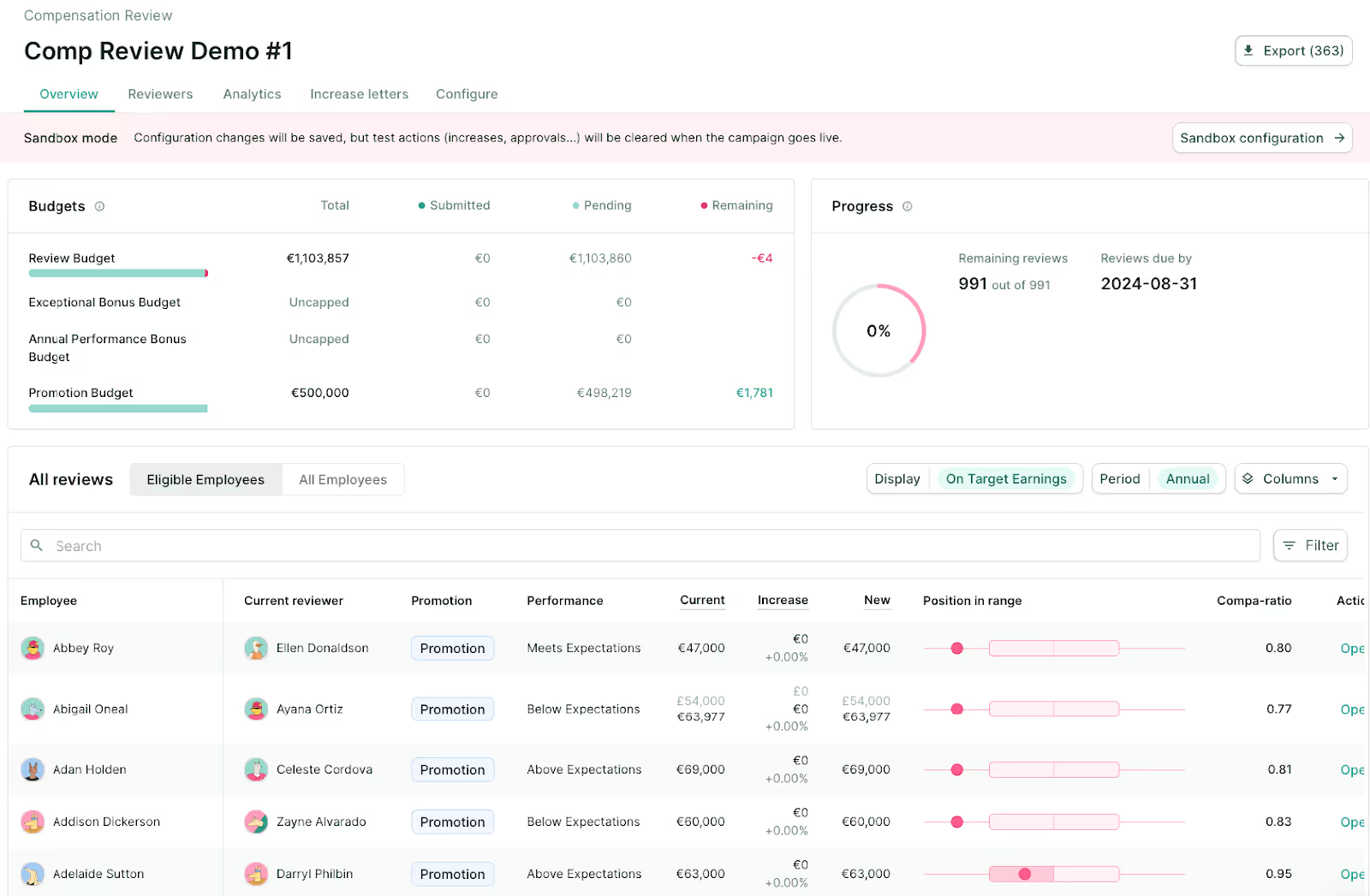Key points:
- Market-based compensation planning uses real-time data instead of outdated annual surveys to keep pay competitive and prevent talent loss.
- Building an effective compensation plan requires 8 steps: from initial market research through regular monitoring and updates.
- Fair pay directly impacts business results – 81% of employees work harder and stay longer when compensated fairly.
- The EU Pay Transparency Directive (2026) makes structured compensation planning mandatory, requiring clear pay structures and equity monitoring.
- Modern tools like Figures replace error-prone spreadsheets with automated benchmarking, collaborative reviews, and compliance features – turning months of manual work into confident, data-driven decisions.
Compensation planning is the strategic process organisations use to design and manage employee pay and benefits. It involves determining salaries, designing reward systems like bonuses and incentives, and ensuring everything aligns with business goals, industry standards, and employee performance.
Here’s a not-so-shocking statistic: 81% of workers feel more productive and loyal to their employers when they are paid fairly. That’s more than four out of five employees who could become your biggest advocates, simply by getting compensation right.
Still, building a system isn’t easy or simple. It’s made up of two equally important parts: direct compensation (salaries and bonuses) and indirect compensation (healthcare, retirement plans, perks, and professional development opportunities).
When you nail this balance, you create a competitive advantage that attracts top talent while building lasting loyalty throughout your organisation.
Sounds tempting? Continue reading to see how you can do that yourself.
Why do you need a compensation plan: importance and objectives
Why bother with compensation planning? Because it transforms how your business operates.
- Well-designed compensation helps you attract and retain talent. When people know they’ll be fairly rewarded, they’re more likely to join your team – and stay there.
- Proper compensation planning improves employee motivation, engagement, and well-being. We’re not making this up – there’s actually a whole university research paper about it.
- Fair compensation directly impacts productivity. Happy employees work harder, better, faster, and yes, you guessed it, stronger.
- Structured compensation planning upholds fairness and equity across your organisation. This prevents the resentment that comes from pay disparities and builds trust amongst your team.
- Good planning ensures that compensation aligns with your company’s budget and strategic goals, rather than being an afterthought that derails your finances.
- Compensation planning ensures compliance with regulations, such as the upcoming EU Pay Transparency Directive, protecting your business from legal risks while demonstrating your commitment to fair employment practices.
How to create a strong compensation plan
Conduct market research
Forget annual salary surveys that tell you what companies paid last year. Market-based compensation planning uses real-time data to make decisions based on what's happening right now.
Here are the three things you need to research:
- Salary benchmarking: Compare your pay rates against market standards for similar positions. Data-driven decisions reduce guesswork completely – instead of wondering whether you're paying competitively, you'll know exactly where you stand. Modern compensation management tools like Figures provide real-time market data across 5 million data points, giving you confidence in every pay decision. This enables truly market-based decisions vs. competitors' static surveys.
- Geographic pay differentials: A London software engineer’s salary is different than the one in Manchester, even for identical work. Smart companies adjust compensation based on local cost of living and market conditions.
- Industry-specific considerations: Tech companies typically offer equity packages, healthcare organisations offer pension contributions, financial services offer substantial bonuses, and non-profits might focus on comprehensive benefits and meaningful work. Adapt smart!
Align with company philosophy
Your compensation plan should reflect who you are as a business, and we’re not just talking about putting some nice words on paper – actually match your pay practices to your company values.
A compensation philosophy answers two fundamental questions: what are your goals for compensation, and why do you believe in those goals?
- If your company values transparency, consider open salary bands or clear promotion criteria.
- If you prioritise work-life balance, emphasise comprehensive benefits over just base salary.
- If innovation drives your culture, performance-based bonuses might take centre stage.
Companies like Buffer have built their entire compensation strategy around transparency, even publishing all employee salaries publicly.

Meanwhile, other organisations focus on equity participation to align everyone with long-term success.
The point is simple: when promises and reality align, you create authentic employee experiences that attract the right people and keep them engaged.
Set objectives and a budget
Start by defining what you want your compensation plan to achieve. Are you trying to reduce turnover by 20%? Attract senior talent in competitive markets? Improve employee satisfaction scores?
Your objectives should be specific, measurable, and tied to business outcomes. Vague goals like “improve employee happiness” won't help you make tough decisions when budget constraints arise.
Speak of the devil…
Most companies can’t afford to pay everyone at the 90th percentile, so you’ll probably have to make strategic choices about where to invest. Perhaps you’ll prioritise competitive salaries for hard-to-fill technical roles whilst offering strong benefits packages across the board.
In any case, you must consider both immediate costs and long-term implications. That generous equity programme might seem affordable now, but what happens when your company valuation increases? Factor in salary progression, promotion budgets, and market adjustments to avoid nasty surprises later.
{{cta}}
Define roles, grades, and salary ranges
Start by grouping similar roles into job families – your marketing coordinator and content specialist might belong in the same family, creating clear career progression paths.
Next, establish grade levels within each family. These grades reflect increasing responsibility, complexity, and impact. A Grade 3 analyst handles routine tasks, whilst a Grade 5 analyst manages complex projects and mentors junior staff.
🧐 Pro tip: Salary ranges then define the minimum and maximum pay for each grade. The key is creating ranges that are wide enough to reward growth but narrow enough to prevent huge disparities between similar roles.
Well-designed salary bands also prepare you for the EU Pay Transparency Directive, which requires clear, justifiable pay structures.
Ensure equity and fairness
Regular pay audits help identify potential disparities before they become problems. Look beyond basic salary to examine bonus distributions, promotion rates, and access to development opportunities. Sometimes what appears fair on the surface reveals concerning patterns when analysed by gender, ethnicity, or other protected characteristics.
The upcoming EU Pay Transparency Directive makes equity monitoring mandatory for many organisations. Companies with unexplained pay gaps exceeding 5% must conduct joint assessments and implement corrective action plans.
Beyond compliance, fair compensation practices improve employee trust and retention. When people believe they’re paid equitably, engagement increases and turnover decreases. This creates a positive cycle where better retention reduces recruitment costs, freeing up budget for competitive compensation.
Use tools and data to remove subjectivity from pay decisions. Clear criteria for raises and promotions help eliminate unconscious bias while providing transparent pathways for career advancement.
Collaborate with leadership and stakeholders
Successful compensation planning requires buy-in from multiple stakeholders, each with their own unique perspective. And getting everyone aligned on compensation is a lot like herding cats, except these cats have budget opinions and strong feelings about market positioning. For example:
- Your CEO provides strategic direction about how compensation supports business goals.
- The finance team offers insights into budget constraints and long-term sustainability.
- Managers understand day-to-day performance and retention challenges.
- Employee representatives can highlight concerns and priorities that might otherwise be overlooked.
Regular cross-functional meetings ensure everyone stays aligned as market conditions change. When a competitor starts offering significant signing bonuses, you need to respond quickly – but only if all stakeholders understand the implications for budget and equity.
Documentation matters too. Clear meeting notes and decision rationales help explain compensation choices to employees and provide protection during audits or disputes. When stakeholders understand and support the process, they become advocates rather than obstacles, making implementation smoother and more credible.
Communicate with employees
Effective communication starts with explaining your compensation philosophy and how decisions are made. Employees want to understand the criteria for raises, bonuses, and promotions – not just the amounts they receive.
Consider implementing different levels of transparency. Some companies share full salary bands with all employees, whilst others provide individual band information only. The right approach depends on your culture and readiness for open discussions about pay. While partial disclosure might feel safer, it leaves employees guessing and creates an environment of mistrust. Embracing full transparency requires courage and preparation, but maintaining secrecy is outdated and puts companies at a serious disadvantage in attracting top talent.
The success of any compensation strategy – especially transparent ones – depends on how and when you communicate with employees. Regular compensation conversations shouldn’t happen only during annual reviews. Quarterly check-ins allow managers to discuss performance expectations and progression opportunities before problems arise.
🧐 Pro tip: Train your managers on compensation communication. They’re often the first point of contact for pay-related questions and need confidence to explain decisions accurately and empathetically.
Monitor and update regularly
Market conditions change rapidly, especially in competitive industries. Annual compensation reviews help you stay competitive, but many companies now conduct reviews twice yearly to keep pace with market movements.
Thankfully, technology makes monitoring easier than ever, and you don’t have to read reports before bedtime to stay current. Modern compensation management platforms provide real-time market data and automated alerts when salaries drift from target ranges. This allows proactive adjustments rather than panicked scrambles when key employees threaten to leave.
Regular reviews also help identify emerging trends. Perhaps remote work is changing geographic pay differentials, or a new competitor is disrupting salary expectations for specific roles. Early detection enables strategic responses rather than costly counter-offers.
Track metrics beyond just salary levels. Monitor retention rates, promotion patterns, and employee satisfaction scores to understand whether your compensation strategy achieves its intended goals. When data shows problems, adjust quickly to maintain a competitive advantage.
Use Figures to strengthen compensation planning with real-time market data
Comprehensive compensation planning aligns perfectly with Figures’ full-suite approach that covers benchmarking, salary bands, reviews, and pay equity. This integrated platform transforms the traditionally fragmented compensation process into a streamlined, data-driven strategy.
The tool simplifies compensation with real-time market data across 5 million!!! data points, dynamic salary bands, and collaborative salary reviews. Instead of guessing whether your compensation is competitive, you’ll have confidence in every decision.
Figures solves the industry’s most pressing challenges:
- Real-time, reliable market data access: The National Bureau of Economic Research found that salary benchmarking was directly linked to increased retention rates, but traditional salary surveys often lag months behind market reality. With competitive pay strategies backed by current data, you can retain talent while controlling costs.

- Moving beyond outdated spreadsheets:
"HR teams can spend weeks manually updating compensation spreadsheets, only to realise their benchmarking data is already outdated. Modern compensation planning requires tools that can keep pace with how quickly the market moves," explains Agnès Chauvigny, VP People at Figures.

- Enhanced stakeholder collaboration: Now your HR, finance, and management teams are all synced through shared dashboards and automated workflows.
- Regulatory compliance: Figures helps ensure compliance through built-in pay equity analysis and transparent reporting. As a member of the Pay Transparency Alliance, Figures stays ahead of regulatory requirements, protecting your organisation whilst promoting fair compensation practices.
Transform your compensation planning with Figures
Effective compensation planning requires market research, clear processes, and ongoing monitoring. But manual spreadsheets and outdated surveys just can’t keep up with growing demand and changing data.
Figures transforms this challenge with 5 million+ real-time market data points, dynamic salary bands, and collaborative review processes. You can make confident compensation decisions that support both employee satisfaction and business objectives.
"Compensation is such a key topic and it has always been so difficult to have reliable market data. Thanks to Figures this is now changing and I can't recommend the platform enough!" Roxanne Varza, Director @Station F
Ready to transform your compensation strategy? Book a demo and discover how Figures can help you build fair, competitive compensation that works for everyone.
Summarize this article with AI
No time to read it all? Get a clear, structured, and actionable summary in one click.


.png)
.png)
.jpg)

